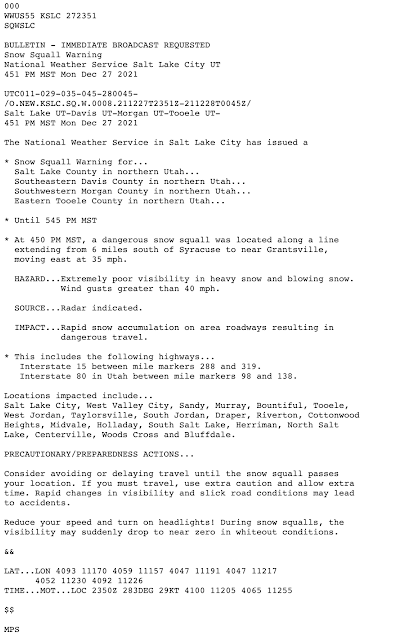As of 7 AM this morning, Alta-Collins has had 22 inches of snow since 10 AM yesterday with 2.08 inches of water. Total snow depth is now at 96 inches, putting us at the precipice for Steenburgh Winter (100 inches at Alta-Collins before 10 February).
A big contributor to the water totals was an intense snowband that setup in the southwesterly flow along the Alpine Ridge between Little Cottonwood and American Fork Canyons. Below is a screenshot showing the band at 23:43 UTC (4:43 PM MST).
From 2300–0200 UTC (4-7 PM MST) Alta-Collins recorded 1.06" of water equivalent snowfall, including 0.42" in the hour ending at 0100 UTC (6 PM MST), for an average of 0.35" per hour. Anything at or above 0.3" really gets my attention as being out there for Little Cottonwood Canyon. The Alta-Collins snowstake camera at 6:12 PM MST showed a dome-like pile of large graupel consistent with strong convection within the band.
Little wonder that SR-210 turned into a cluster yesterday afternoon or that the canyon was closed last night.
I've seen similar bands setup in southwest flow on a few occasions, but don't understand the mechanism for formation. At times, the radar imagery suggests a connection to the southwest end of the Oquirrh Mountains. You can see in the radar image above that radar echoes ≥ 30 dBZ extend all the way to Point of the Mountain and there's a hint of something extending all the way to Cedar Fort.
Thus, I don't think these bands solely reflect lifting by the Alpine Ridge. My guess is that the band is initiated by flow interactions with the Oquirrh Mountains, but amplifies downstream over the central Wasatch. This has been shown to occur in other regions where ridge-gap corrugations in topography can lead to the development of precipitation bands downstream of the mountains, such as illustrated below for the Alps.
 |
| Source: Siedersleben and Gohm (2016) |
Under the right circumstances, the small scale circulations induced by flow interactions with these ridge-gap corrugations can lead to instabilities that result in band formation. The end of a mountain range can also produce such circulations and perhaps that is the case sometimes for the southern tip of the Oquirrhs.
Meanwhile, as of Friday morning, we are transitioning into the unstable, postfrontal phase of the storm. A time-height section from the GFS shows this persisting into Saturday morning when a layer of stable, dry air associated with the upstream ridge moves over Utah. Flow directions from today through then at crest level (700 mb) are generally from westerly to northwesterly. I'd like to see things locked in at northwesterly, but we should see periods of snow in the Cottonwoods regardless and a chance of lake-effect late tonight and tomorrow morning.
It's worth a look at the GFS-derived forecast guidance for upper Little Cottonwood. Temperatures on Mt. Baldy (11,000 ft) drop steadily today and tonight, bottoming out at -13˚F tomorrow morning. The NAM and GFS forecast 700-mb (10,000 ft) temperatures to bottom out at -20.5˚C (-5˚F) and -20.1˚C (-4˚F) tomorrow morning as well. Anything below -20˚C is very cold for northern Utah. Bundle up!
The GFS water-equivalent total for 9 AM this morning through 9 AM tomorrow morning is 0.32" and about 6" of snow. We are solidly in the post-frontal crapshoot for this one. Unstable flow is good, although it's not always solidly northwesterly in the forecast. By tomorrow morning, temperatures are low enough that we might see the best zone for snow growth shifting to below upper-elevations. Dendritic snow growth occurs at temperatures between -12 and -18˚C and we'll be colder than that above 10,000 feet. Did I mention the lake? Yeah it's another possibility. Finally, the snow we get today and this evening should be of the cold-smoke variety, so it won't take much water to give a big snowfall.
I'm going to go for another 8-14" of snow at Alta Collins from 9 AM this morning to 9 AM tomorrow morning. If that comes through, there's a pretty good chance that New Years Day will also be the official start of Steenburgh Winter.



















































